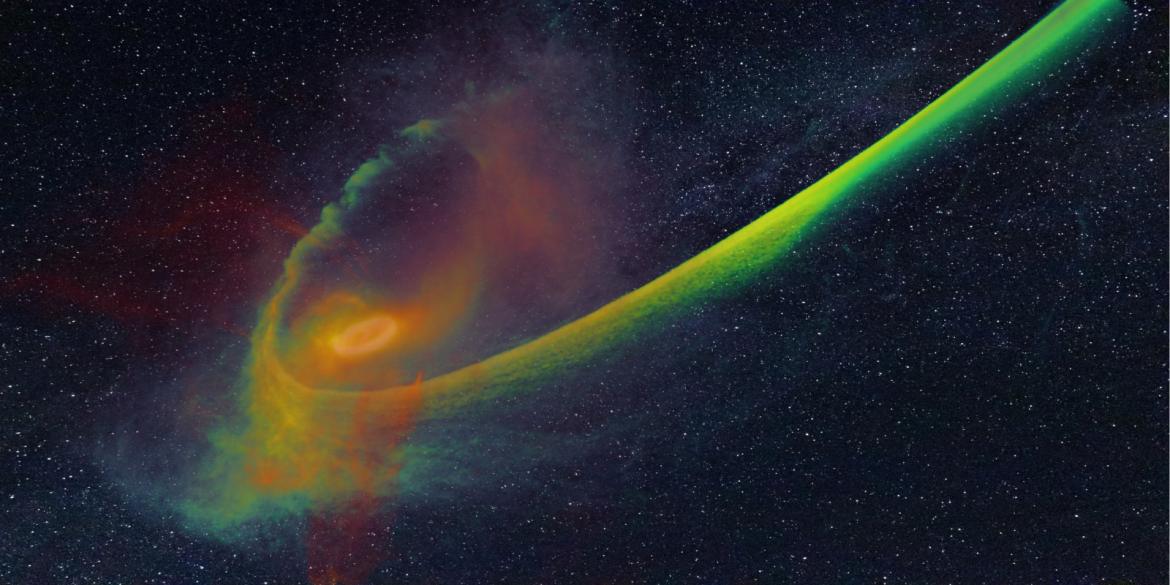
A new study by Hebrew University is a significant breakthrough in understanding Tidal Disruption Events (TDEs) involving supermassive black holes. The new simulations, for the first time ever, accurately replicate the entire sequence of a TDE from stellar disruption to the peak luminosity of the resulting flare. This study has unveiled a previously unknown type of shockwave within TDEs, settling a longstanding debate about the energy source of the brightest phases in these events. It confirms that shock dissipation powers the brightest weeks of a TDE flare, opening doors for future studies to utilize TDE observations as a means to measure essential properties of black holes and potentially test Einstein’s predictions in extreme gravitational environments.
The mysteries of supermassive black holes have long captivated astronomers, offering a glimpse into the deepest corners of our universe. Now, a new study led by Dr Elad Steinberg and Dr Nicholas C. Stone at the Racah Institute of Physics, The Hebrew University, sheds new light on these enigmatic cosmic entities.
Supermassive black holes, ranging from millions to billions of times the mass of our Sun, have remained elusive despite their pivotal role in shaping galaxies. Their extreme gravitational pull warps spacetime, creating an environment that defies conventional understanding and presents a challenge for observational astronomers.
Enter Tidal Disruption Events (TDEs), a dramatic phenomenon that occurs when ill-fated stars venture too close to a black hole’s event horizon, and are torn apart into thin streams of plasma. As this plasma returns towards the black hole, a series of shockwaves heat it up, leading to an extraordinary display of luminosity—a flare that surpasses the collective brightness of an entire galaxy for weeks or even months.
The study conducted by Steinberg and Stone represents a significant leap forward in understanding these cosmic events. For the first time, their simulations have recreated a realistic TDE, capturing the complete sequence from the initial star disruption to the peak of the ensuing luminous flare, all made possible by pioneering radiation-hydrodynamics simulation software developed by Steinberg at The Hebrew University.
This research has uncovered a previously unexplored type of shockwave within TDEs, revealing that these events dissipate their energy at a faster rate than previously understood. By clarifying this aspect, the study resolves a long-standing theoretical debate, confirming that the brightest phases of a TDE flare are powered by shock dissipation—a revelation that sets the stage for comprehensive exploration by observational astronomers.
These findings pave the way for translating TDE observations into precise measurements of crucial black hole properties, including mass and spin. Moreover, these cosmic occurrences could serve as a litmus test for validating Einstein’s predictions in extreme gravitational environments.
Steinberg and Stone’s study not only unravels the intricate dynamics of TDEs but also opens a new chapter in our quest to comprehend the fundamental workings of supermassive black holes. Their simulations mark a crucial step towards harnessing these celestial events as invaluable tools for deciphering the cosmic mysteries lurking at the heart of galaxies.
The research paper titled “Stream-Disk Shocks as the Origins of Peak Light in Tidal Disruption Events” is now available in Nature and can be accessed here.
Picture
Title: Black Hole Devouring a Star
Description: A star in the midst of being disrupted by a supermassive black hole. As the star wanders past the super massive black hole, the tidal field of the black hole rips apart the star. Half of the star is flung away to infinity and the other half falls back to the black hole. The picture shows the result of the simulation carried out by Steinberg and Stone, showing the density of the infalling half (green-blue color) as well as the heat that is generated by the shocks (white-red).
Credit: Elad Steinberg
Video – Disruption of solar mass star
Disclaimer: In these challenging times of war and crisis, Hebrew University of Jerusalem is resolute in its dedication to advancing research and education. We stand in full support of the brave individuals on the frontlines, safeguarding our nation and the well-being of all Israelis, and extend our deepest gratitude and unwavering solidarity to our community and fellow citizens. Together, we shall prevail against the challenges that confront us, and our shared commitment to the well-being of all Israelis and the pursuit of knowledge remains resolute.
The Hebrew University of Jerusalem is Israel’s premier academic and research institution. With over 25,000 students from 90 countries, it is a hub for advancing scientific knowledge and holds a significant role in Israel’s civilian scientific research output, accounting for nearly 40% of it and has registered over 11,000 patents. The university’s faculty and alumni have earned eight Nobel Prize and a Fields Medal, underscoring their contributions to ground-breaking discoveries. In the global arena, the Hebrew University ranks 86th according to the Shanghai Ranking. To learn more about the university’s academic programs, research initiatives, and achievements, visit the official website at http://new.huji.ac.il/en
